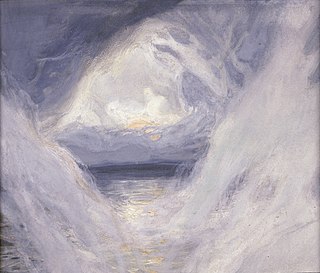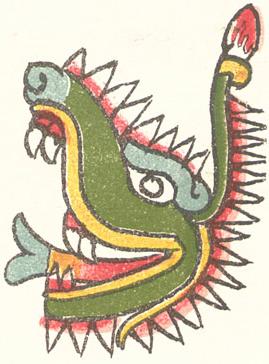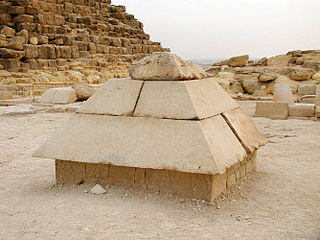Related Research Articles

A creation myth or cosmogonic myth is a type of cosmogony, a symbolic narrative of how the world began and how people first came to inhabit it. While in popular usage the term myth often refers to false or fanciful stories, members of cultures often ascribe varying degrees of truth to their creation myths. In the society in which it is told, a creation myth is usually regarded as conveying profound truths – metaphorically, symbolically, historically, or literally. They are commonly, although not always, considered cosmogonical myths – that is, they describe the ordering of the cosmos from a state of chaos or amorphousness.
A creator deity or creator god is a deity responsible for the creation of the Earth, world, and universe in human religion and mythology. In monotheism, the single God is often also the creator. A number of monolatristic traditions separate a secondary creator from a primary transcendent being, identified as a primary creator.

Cipactli was the first day of the Aztec divinatory count of 13 X 20 days and Cipactonal "Sign of Cipactli" was considered to have been the first diviner. In Aztec cosmology, the crocodile symbolized the earth floating in the primeval waters. According to one Aztec tradition, Teocipactli "Divine Crocodile" was the name of a survivor of the flood who rescued himself in a canoe and again repopulated the earth. In the Mixtec Vienna Codex, Crocodile is a day associated with dynastic beginnings.
Lenape mythology is the mythology of the Lenape people, an Indigenous peoples of the Northeastern Woodlands
Atum, sometimes rendered as Atem or Tem, is the primordial god in Egyptian mythology from whom all else arose. He created himself and is the father of Shu and Tefnut, the divine couple, who are the ancestors of the other Egyptian deities. Atum is also closely associated with the evening sun. As a primordial god and as the evening sun, Atum has chthonic and underworld connections. Atum was relevant to the ancient Egyptians throughout most of Egypt's history. He is believed to have been present in ideology as early as predynastic times, becoming even more prevalent during the Old Kingdom and continuing to be worshiped through the Middle and New Kingdom, though he becomes overshadowed by Re around this time.

Nu or Nun, is the personification of the primordial watery abyss which existed at the time of creation and from which the creator sun god Ra arose, in ancient Egyptian religion. Nu is one of the eight deities of the Ogdoad representing ancient Egyptian primordial Chaos from which the primordial mound arose from. Nun can be seen as the first of all the gods and the creator of reality and personification of the cosmos. Nun is also considered the god that will destroy existence and return everything to the Nun from whence it came. No cult was addressed to Nun.

The world egg, cosmic egg or mundane egg is a mythological motif found in the cosmogonies of many cultures that is present in Proto-Indo-European culture and other cultures and civilizations. Typically, the world egg is a beginning of some sort, and the universe or some primordial being comes into existence by "hatching" from the egg, sometimes lain on the primordial waters of the Earth.

Creatio ex nihilo is the doctrine that matter is not eternal but had to be created by some divine creative act. It is a theistic answer to the question of how the universe comes to exist. It is in contrast to Ex nihilo nihil fit or "nothing comes from nothing", which means that all things were formed from preexisting things; an idea by the Greek philosopher Parmenides about the nature of all things, and later more formally stated by Titus Lucretius Carus.
Mawu-Lisa is a creator goddess, associated with the Sun and Moon in Dahomey mythology. In some myths, she is the wife of the male god Lisa. Mahu and Lisa are the children of Nana Buluku, and are the parents of Xevioso.

In the creation myth of the Heliopolitan form of ancient Egyptian religion, Benben was the mound that arose from the primordial waters Nu upon which the creator deity Atum settled. The Benben stone is the top stone of the pyramid. It is also related to the obelisk.
Mesoamerican creation myths are the collection of creation myths attributed to, or documented for, the various cultures and civilizations of pre-Columbian Mesoamerica and Mesoamerican literature.
Tehom is a Biblical Hebrew word meaning "the deep". It is used to describe the primeval ocean and the post-creation waters of the earth. It derives from a Semitic root which denoted the sea as an unpersonified entity with mythological import.
Sapropel is a term used in marine geology to describe dark-coloured sediments that are rich in organic matter. Organic carbon concentrations in sapropels commonly exceed 2 wt.% in weight.
Chinese creation myths are symbolic narratives about the origins of the universe, earth, and life. In Chinese mythology, the term "cosmogonic myth" or "origin myth" is more accurate than "creation myth", since very few stories involve a creator deity or divine will. Chinese creation myths fundamentally differ from monotheistic traditions with one authorized version, such as the Judeo-Christian Genesis creation narrative: Chinese classics record numerous and contradictory origin myths. Traditionally, the world was created on Chinese New Year and the animals, people, and many deities were created during its 15 days.
Buga is a creator god and omnipotent highest power in the mythology of the Tungusic peoples.

Ancient Egyptian creation myths are the ancient Egyptian accounts of the creation of the world. The Pyramid Texts, tomb wall decorations, and writings, dating back to the Old Kingdom have provided the majority of information regarding ancient Egyptian creation myths. These myths also form the earliest religious compilations in the world. The ancient Egyptians had many creator gods and associated legends. Thus, the world or more specifically Egypt was created in diverse ways according to different parts of ancient Egypt. Some versions of the myth indicate spitting, others masturbation, as the act of creation. The earliest god, Ra and/or Atum, emerged from a chaotic state of the world and gave rise to Shu (air) and Tefnut (moisture), from whose union came Geb (earth) and Nut (sky), who in turn created Osiris, Isis, Set, and Nephthys. An extension to this basic framework was the Osiris myth involving Osiris, his consort Isis, and their son Horus. The murder of Osiris by Set, and the resulting struggle for power, won by Horus, provided a powerful narrative linking the ancient Egyptian ideology of kingship with the creation of the cosmos.
Tatenen was the deity of the primordial mound in ancient Egyptian religion. His name means "risen land" or "exalted earth", as well as referring to the silt of the Nile. As a primeval chthonic deity, Tatenen was identified with creation. Both feminine and masculine, he was an androgynous protector of nature from the Memphis area, the ancient capital of the Inebu-hedj nome in Lower Egypt.

Geb was the Egyptian god of the earth and a mythological member of the Ennead of Heliopolis. He could also be considered a father of snakes. It was believed in ancient Egypt that Geb's laughter created earthquakes and that he allowed crops to grow.
References
- ↑ Mike Dixon-Kennedy, 1998, ABC-CLIO publishers, Encyclopedia of Russian and Slavic Myths and Legends, Accessed July 10, 2014, "...Siberia - Tungus - The creator, who plunged into the primeval waters and brought back a clump of mud from which he fashioned the Earth..."